高中英语 Unit 20《Humour》说课稿4 新人教版
- 格式:doc
- 大小:49.50 KB
- 文档页数:9
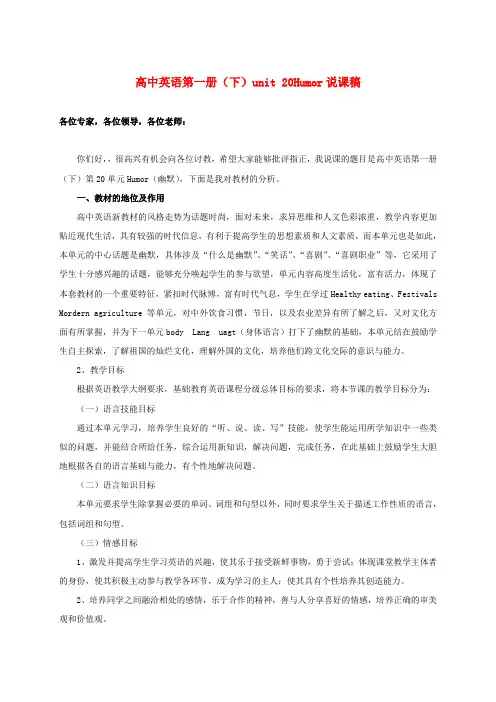
高中英语第一册(下)unit 20Humor说课稿各位专家,各位领导,各位老师:你们好,,很高兴有机会向各位讨教,希望大家能够批评指正,我说课的题目是高中英语第一册(下)第20单元Humor(幽默),下面是我对教材的分析。
一、教材的地位及作用高中英语新教材的风格走势为话题时尚,面对未来,求异思维和人文色彩浓重,教学内容更加贴近现代生活,具有较强的时代信息,有利于提高学生的思想素质和人文素质,而本单元也是如此,本单元的中心话题是幽默,具体涉及“什么是幽默”、“笑话”、“喜剧”、“喜剧职业”等,它采用了学生十分感兴趣的话题,能够充分唤起学生的参与欲望,单元内容高度生活化,富有活力,体现了本套教材的一个重要特征,紧扣时代脉博,富有时代气息,学生在学过Healthy eating、Festivals Mordern agriculture 等单元,对中外饮食习惯,节日,以及农业差异有所了解之后,又对文化方面有所掌握,并为下一单元body Lang uagt(身体语言)打下了幽默的基础,本单元结在鼓励学生自主探索,了解祖国的灿烂文化,理解外国的文化,培养他们跨文化交际的意识与能力。
2、教学目标根据英语教学大纲要求,基础教育英语课程分级总体目标的要求,将本节课的教学目标分为:(一)语言技能目标通过本单元学习,培养学生良好的“听、说、读、写”技能,使学生能运用所学知识中一些类似的问题,并能结合所给任务,综合运用新知识,解决问题,完成任务,在此基础上鼓励学生大胆地根据各自的语言基础与能力,有个性地解决问题。
(二)语言知识目标本单元要求学生除掌握必要的单词、词组和句型以外,同时要求学生关于描述工作性质的语言,包括词组和句型。
(三)情感目标1、激发并提高学生学习英语的兴趣,使其乐于接受新鲜事物,勇于尝试;体现课堂教学主体者的身份,使其积极主动参与教学各环节,成为学习的主人;使其具有个性培养其创造能力。
2、培养同学之间融洽相处的感情,乐于合作的精神,善与人分享喜好的情感,培养正确的审美观和价值观。
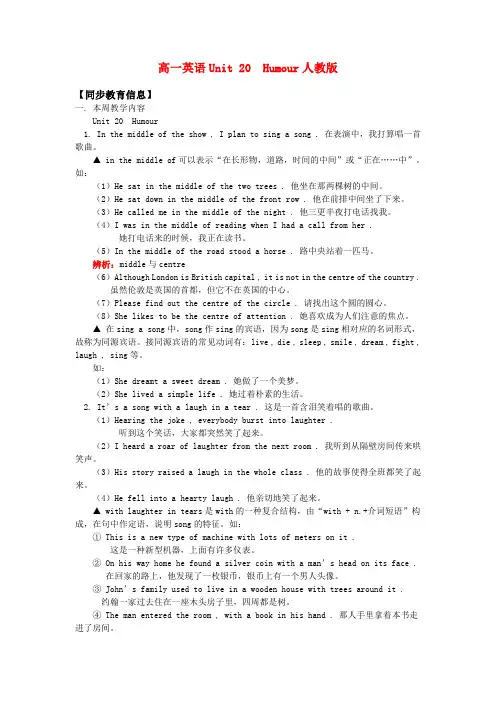
高一英语Unit 20 Humour人教版【同步教育信息】一. 本周教学内容Unit 20 Humour1. In the middle of the show , I plan to sing a song . 在表演中,我打算唱一首歌曲。
▲ in the middle of可以表示“在长形物,道路,时间的中间”或“正在……中”。
如:(1)He sat in the middle of the two trees . 他坐在那两棵树的中间。
(2)He sat down in the middle of the front row . 他在前排中间坐了下来。
(3)He called me in the middle of the night . 他三更半夜打电话找我。
(4)I was in the middle of reading when I had a call from her .她打电话来的时候,我正在读书。
(5)In the middle of the road stood a horse . 路中央站着一匹马。
辨析:middle与centre(6)Although London is British capital , it is not in the centre of the country .虽然伦敦是英国的首都,但它不在英国的中心。
(7)Please find out the centre of the circle . 请找出这个圆的圆心。
(8)She likes to be the centre of attention . 她喜欢成为人们注意的焦点。
▲在sing a song中,song作sing的宾语,因为song是sing相对应的名词形式,故称为同源宾语。
接同源宾语的常见动词有:live , die , sleep , smile , dream , fight , laugh , sing等。

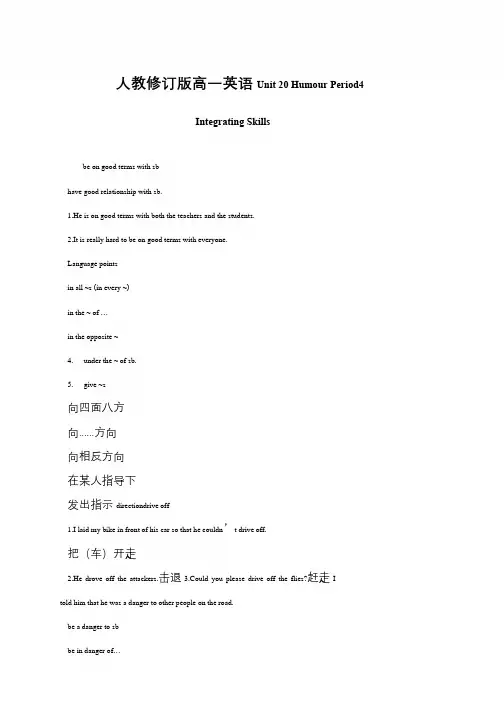
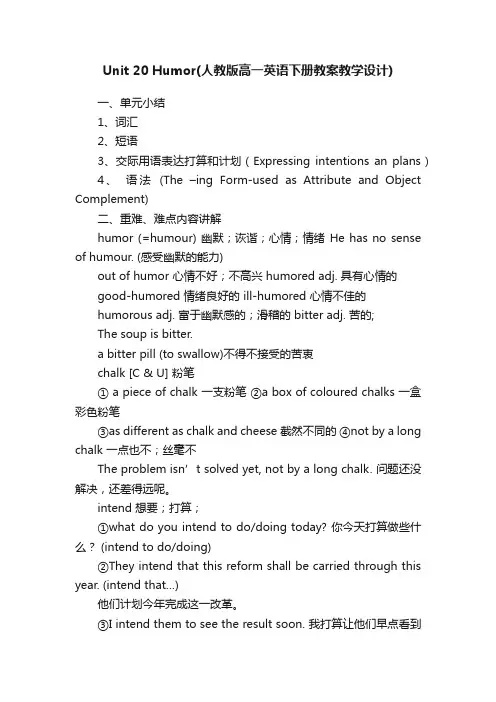
Unit 20 Humor(人教版高一英语下册教案教学设计)一、单元小结1、词汇2、短语3、交际用语表达打算和计划(Expressing intentions an plans)4、语法(The –ing Form-used as Attribute and Object Complement)二、重难、难点内容讲解humor (=humour) 幽默;诙谐;心情;情绪 He has no sense of humour. (感受幽默的能力)out of humor 心情不好;不高兴 humored adj. 具有心情的good-humored 情绪良好的 ill-humored 心情不佳的humorous adj. 富于幽默感的;滑稽的 bitter adj. 苦的;The soup is bitter.a bitter pill (to swallow)不得不接受的苦衷chalk [C & U] 粉笔① a piece of cha lk 一支粉笔②a box of coloured chalks 一盒彩色粉笔③as different as chalk and cheese 截然不同的④not by a long chalk 一点也不;丝毫不The problem isn’t solved yet, not by a long chalk. 问题还没解决,还差得远呢。
intend 想要;打算;①what do you intend to do/doing today? 你今天打算做些什么? (intend to do/doing)②They intend that this reform shall be carried through this year. (intend that…)他们计划今年完成这一改革。
③I intend them to see the result soon. 我打算让他们早点看到结果。
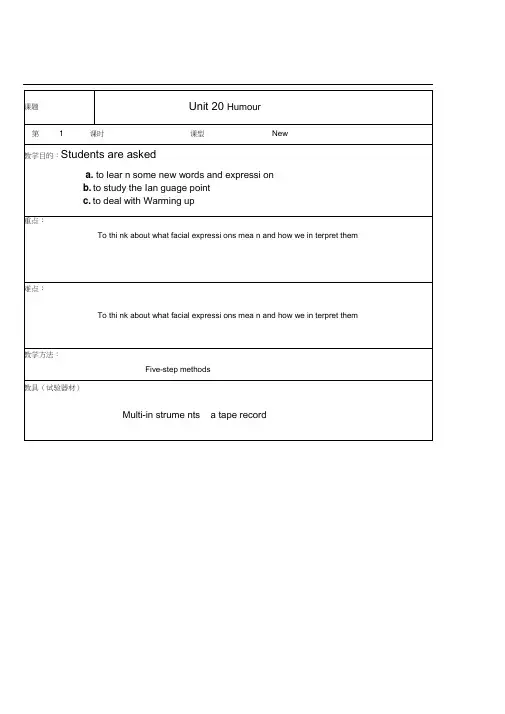
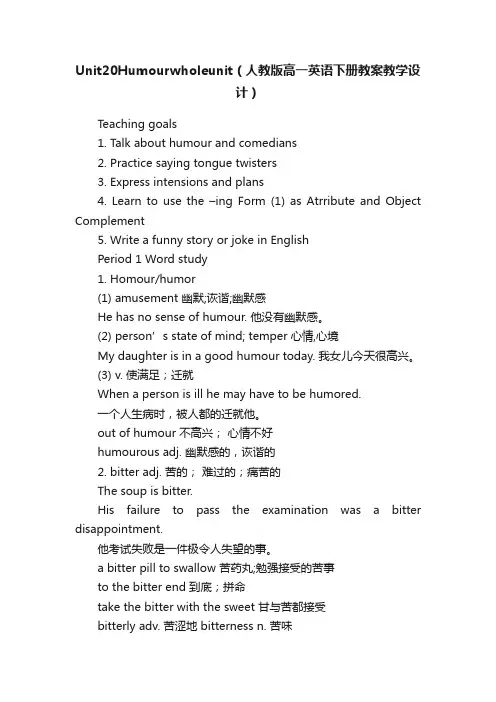
Unit20Humourwholeunit(人教版高一英语下册教案教学设计)Teaching goals1. Talk about humour and comedians2. Practice saying tongue twisters3. Express intensions and plans4. Learn to use the –ing Form (1) as Atrribute and Object Complement5. Write a funny story or joke in EnglishPeriod 1 Word study1. Homour/humor(1) amusement 幽默;诙谐;幽默感He has no sense of humour. 他没有幽默感。
(2) person’s state of mind; temper 心情,心境My daughter is in a good humour today. 我女儿今天很高兴。
(3) v. 使满足;迁就When a person is ill he may have to be humored.一个人生病时,被人都的迁就他。
out of humour 不高兴;心情不好humourous adj. 幽默感的,诙谐的2. bitter adj. 苦的;难过的;痛苦的The soup is bitter.His failure to pass the examination was a bitter disappointment.他考试失败是一件极令人失望的事。
a bitter pill to swallow 苦药丸;勉强接受的苦事to the bitter end 到底;拼命take the bitter with the sweet 甘与苦都接受bitterly adv. 苦涩地 bitterness n. 苦味3. comedy 喜剧 tragedy 悲剧comedian 喜剧演员;行动滑稽的人comedienne 喜剧中的女演员;女丑角He prefers comedy to tragedy.Comedians often work alone or as a pair.Song Dandan is a popular comedienne.4. intend v. ---have in mind as a purpose or plan 打算;意欲intend to do sth 打算做…intend that… 打算;intend sb to do sth 想让某人做某事be intended for 是为…设计的intend to have done sth. 本想做某事(而没做)intention n. 意图;目的;意旨1.你今天打算做什么?.2.他们计划今年完成这一工程。
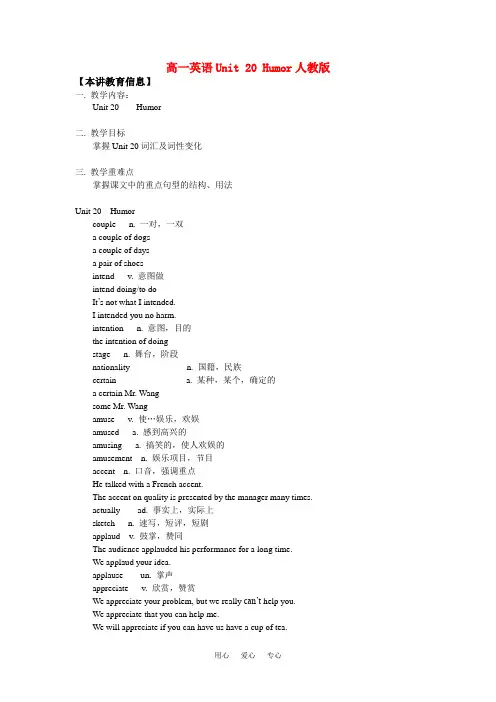
高一英语Unit 20 Humor人教版【本讲教育信息】一. 教学内容:Unit 20 Humor二. 教学目标掌握Unit 20词汇及词性变化三. 教学重难点掌握课文中的重点句型的结构、用法Unit 20 Humorcouple n. 一对,一双a couple of dogsa couple of daysa pair of shoesintend v. 意图做intend doing/to doIt’s not what I intended.I intended you no harm.intention n. 意图,目的the intention of doingstage n. 舞台,阶段nationality n. 国籍,民族certain a. 某种,某个,确定的a certain Mr. Wangsome Mr. Wangamuse v. 使…娱乐,欢娱amused a. 感到高兴的amusing a. 搞笑的,使人欢娱的amusement n. 娱乐项目,节目accent n. 口音,强调重点He talked with a French accent.The accent on quality is presented by the manager many times.actually ad. 事实上,实际上sketch n. 速写,短评,短剧applaud v. 鼓掌,赞同The audience applauded his performance for a long time.We applaud your idea.applause un. 掌声appreciate v. 欣赏,赞赏We appreciate your problem, but we really can’t help you.We appreciate that you can help me.We will appreciate if you can have us have a cup of tea.fluent a. 流利的fluency n. 流利with fluencydate back todate fromup to dateto dateout of dateput a date to sth.under the date of may 1stexist v. 存在existence n. 存在in existencesuffer v. 遭受suffer from headachessuffer pain/defeatsuffering n. 痛苦(通常复数)operate v. 操作,动手术operate on sb.drive offfortunate a. 幸运的fortune n. 好运by a stroke of fortunemake a fortuneconfuse v. 使迷惑,困惑confusing a. 使人迷惑的,令人费解的confused a. 感到困惑的confusion n. 困惑in confusiondirection n. 方向,说明书in a northerly directionsilence n. 沉默不语silent a. 沉默的silent,quiet与calmsilent指人或动物不发声,不做声。

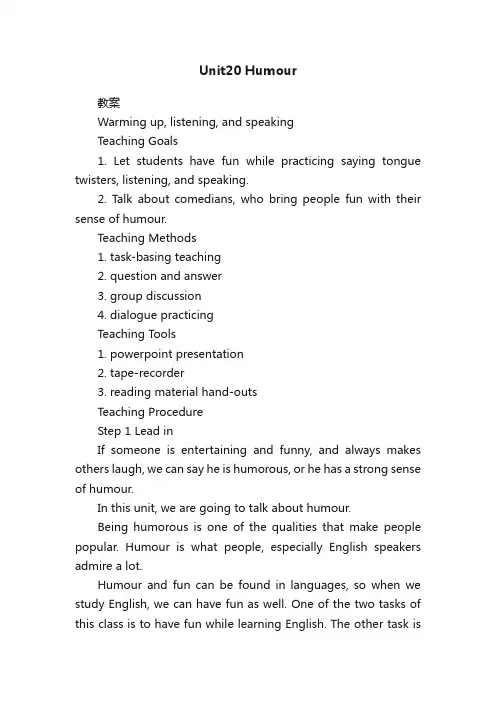
Unit20 Humour教案Warming up, listening, and speakingTeaching Goals1. Let students have fun while practicing saying tongue twisters, listening, and speaking.2. Talk about comedians, who bring people fun with their sense of humour.Teaching Methods1. task-basing teaching2. question and answer3. group discussion4. dialogue practicingTeaching Tools1. powerpoint presentation2. tape-recorder3. reading material hand-outsTeaching ProcedureStep 1 Lead inIf someone is entertaining and funny, and always makes others laugh, we can say he is humorous, or he has a strong sense of humour.In this unit, we are going to talk about humour.Being humorous is one of the qualities that make people popular. Humour is what people, especially English speakers admire a lot.Humour and fun can be found in languages, so when we study English, we can have fun as well. One of the two tasks of this class is to have fun while learning English. The other task isto talk about comedians, who bring people fun with their sense of humour.Step 2 Have fun I tongue twistersSay something funnyTry to speak fast without making mistakes!I will give you several minutes to practise by yourselves. After that, we’l l have a competition.1. Betty bought some butter, but the butter was bitter, so she bought some better butter to make the bitter butter better.2. I wish to wish the wish you wish to wish, but if you wish the wish the witch wishes, I won’t wish the wish y ou wish to wish.3. If white chalk chalks white on a black blackboard,will black chalk chalk black on a white whiteboard then?Now we will see who can speak fastest and best .For each sentence, there are 2 chances. One for the boys, and the other for the girls.Step 3 Have FunII ListeningListen to something funnyBefore listening, let’s go through the following questions.What was the man’s job?He was a minister in the churchIn England, who can marry couples in church?A ministerWhere did the woman ask the minister to marry her?In a restaurant.When did he ask her to marry him?A few days laterNow, please listen carefully, and try to find the answers to the questions.Check the answers.Listen to the tape once again, try to number the pictures on page 50&51.The story begins from picture 5.What is the fun of the story?“Marry” has two meanings: one is to become someone’s wife or husband, and the other is to perform the wedding service.Step 4 Have fun III.Readingread something funny.Work in groups of four. Each group will have one copy. There are four pieces of paper in each copy. Make sure every in your group will have one piece. After you read your part, exchange yours with others. Think about and discuss on the two questions while reading.1. Do you enjoy them? What is the fun? Try to explain simply.2. Can the stories be translated into Chinese?A---- If we become engaged(订婚), will you give me a ring?---- Sure, what’s your phone number?---- John says I’m pretty, Andy says I’m ugly. What do you think, Peter?---- A bit of both. I think you’re pretty ugly.B. Just A MinuteA woman telephoned an airplane office in New York City and asked, “How long does it take to fly to San Francisco? ” “Just a minute,” said the man who answered. “Thank you.” The woman said and hung up.C.Dear Dad,$chool i$ really $well. I am making lot$ of friend$ and $tudying very hard. I have $o much $tuff. I $imply can’t think of anything I need, $o if you like, $end me a card, a$ I would love tohear from you.Love, Your $onDear Son,I kNOw astroNOmy, ecoNOmics, and oceaNOgraphy are eNOugh to keep an hoNOrs student busy. Do NOt forget that the pursuit of kNOwledge is a NOble task, and you can’t study eNOugh.Love, DadD. He’s MovingAfter dying in a car crash, three friends go to heaven. They are all asked the same question. “When you are lying in your casket(棺材) and friends and family are mourning(哀悼) over you, what would you like to hear them say about you?” the first guy immediately responds, “I would like to hear them say t hat I was one of the greatest doctors of my time, and a great family man.”The second guy says, “I would like to hear that I was a wonderful husband and school teacher who made a great difference in the children of tomorrow.” the last guy thinks for a momen t, and then replies, “I guess I’d like to hear them say, ‘Look, he’s moving!’ ”Only the last one can be translated. If the others are translated into English, there’ll be no fun. The kind f humor will disappear.So learning English can bring us fun, right?Step 5 SpeakingTalk about comediansIn our daily life, there are people whose job is to bring people fun and make people laugh. Now let’s look at a photo. Who is he?He is Stephen Chou. He is a comedian. The word comediancomes from comedy, which means a film or play that entertains people and makes people laugh.Let’s have a look at some other photos of some comedians.Charlie Chaplin.Stan Laurel & Oliver Hardy, who learnt a lot from Charlie Chapin.Mr. Bean, whose expressions and gestures are always funny.Dustin Hoffman, who is dressed like a beautiful woman in the picture.Chen Peisi.Ma Ji, a crosstalk comedian.Cai Ming.Song Dandan.Do you like comedians? Why? Complete the sentence.I like comedians because they _____________ (they are funny/ they bring me fun/ they make people laugh, etc.)I don’t like comedians because they _____________Practise the dialogue.Now let’s listen to a dialogue between a journalist and a comedian. Think about a question:Besides making people laugh, what do comedians do?They make people think about life.Now, we’ll enjoy a show by Cai Ming and Guo Da.Did it make you laugh?Did it make you think about life?Please read the dialogue.We have talked about comedians. Do you want to be comedians? Do you want to be journalists who can interview comedians?Make up a similar dialogue.Work in pairs. One is a journalist, and the other can choose to be Charlie Chaplin, Stephen Chou, Ma Ji or any comedian you like. You can ask and answer questions on career, experiences, purpose, success, family and so on.Step6 revieing and conclusionLearning a foreign language is not easy, but it can be fun as well. Enjoy it. Remember, it brings you great pleasure when you understand humour in a foreign language.Humour not only gives you pleasure, but also makes you think about life. Those comedians who only try to entertain people without making people think are not great comedians. Humour that is not combined with wisdom cannot be called true humour.HomeworkPreview the passage on page 52。
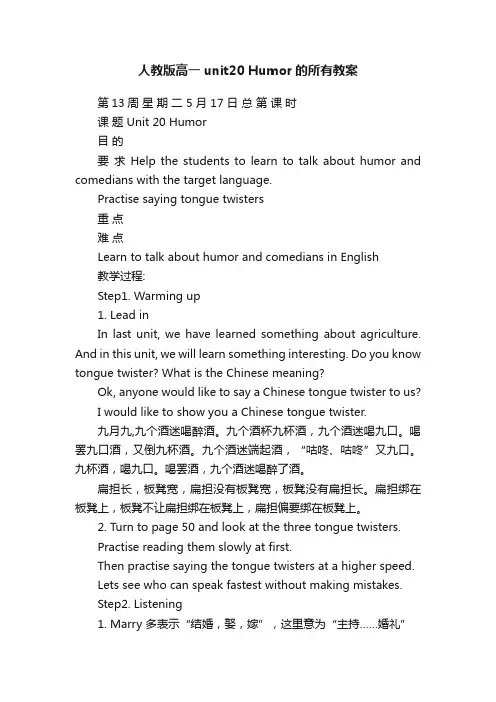
人教版高一unit20 Humor的所有教案第13周星期二 5 月 17 日总第课时课题 Unit 20 Humor目的要求Help the students to learn to talk about humor and comedians with the target language.Practise saying tongue twisters重点难点Learn to talk about humor and comedians in English教学过程:Step1. Warming up1. Lead inIn last unit, we have learned something about agriculture. And in this unit, we will learn something interesting. Do you know tongue twister? What is the Chinese meaning?Ok, anyone would like to say a Chinese tongue twister to us?I would like to show you a Chinese tongue twister.九月九,九个酒迷喝醉酒。
九个酒杯九杯酒,九个酒迷喝九口。
喝罢九口酒,又倒九杯酒。
九个酒迷端起酒,“咕咚、咕咚”又九口。
九杯酒,喝九口。
喝罢酒,九个酒迷喝醉了酒。
扁担长,板凳宽,扁担没有板凳宽,板凳没有扁担长。
扁担绑在板凳上,板凳不让扁担绑在板凳上,扁担偏要绑在板凳上。
2. Turn to page 50 and look at the three tongue twisters.Practise reading them slowly at first.Then practise saying the tongue twisters at a higher speed.Lets see who can speak fastest without making mistakes.Step2. Listening1. Marry 多表示“结婚,娶,嫁”,这里意为“主持……婚礼”e.g. The priest married them.The headmaster will marry the couples.2. Listen to the tape for three times3. Check the answerexercise 1: 6,5,4,3,1,2exercise 2:(1). He was a minister in the church.(2). A minister.(3). About eight kilometers from each other.(4). In a restaurant.(5). A few days later.Step3. Homework1. Preview speaking, pre-reading & reading2. Review last unit and prepare for the test3. Dictation1. couple2. minister3. tongue twister4. bitter5. humorous6. chalk7. chalk 8. intend 9. stage 10. German第13周星期四 5 月19日总第课时课题 Unit 20 Speaking & reading目的要求 Learn some reading skillsLearn how to find the topic sentence and get the main idea.Talk about humor and comedians重点难点Enable students to compare Western and Chinese comedy shows and create a funny show.教学过程:Step1. Dictation1. couple2. minister3. tongue twister4. bitter5. humorous6. chalk7. chalk 8. intend 9. stage 10. GermanStep2. speaking1. Read the dialogue2. explain some language points(1) stillstill用作副词,意为“尽管如此;然而;但还是”。
Unit20 Humour教案(人教版高一英语教案教学设计)Ⅰ.Teaching Goals:1.Talk about humour and comedians.2.Practise saying tongue twisters.3.Express intentions and plans.e the-ing form(1)as the Attribute and Object Complement.5.Write a funny story or joke in English.Plays on words can also be in the form of a riddle.And some riddles are plays on compound words.A compound word consists of two or more pants,and the pants do not have the same meaning as they have when they are used separately,though they may keep their original sound.Here are some examples:(1)I work only when I’m fired.What am I ?(A rocket.)(2)I have teeth,but no mouth.What am I?(A comb.)(3)I have a mouth,but no teeth,what am I?(A river.)Some jokes are based on words which have the same sound but different meanings and spellings.Jokes of this kind is better heard,not seen.When they are written or printed,the humor is largely lost.For example:Seven days without water makes one weak (week).We must all hang together or we shall all hang separately.The First PeriodTeaching Aims:1.Practise saying tongue twisters.2.Do some listening.3.Talk about intentions and plans.4.Learn and master the new words and expressions of this part.Teaching Important Points:1.Improve the students' listening ability by listening.2.Improve the students' speaking ability by making up dialogues.3.Let the students master how to impress their intentions and plans.Teaching Difficult Points:1.Make dialogues to express their ideas.2.Say tongue twisters fluently.Teaching Methods:1.Listening and speaking methods to improve the students' listening and speaking ability.2.Pair work or group work to make every student active in class activities.Teaching Aids:1.a tape recorder2.a projector and some slides3.a computer for multimedia useTeaching Procedures:Step Ⅰ.Greetings and RevisionT:Good morning,everyone.Ss:Good morning,teacher.T:Sit down,please.In the last period,I told you to make sentences with the expressions of Unit 19 and say them in groups.In this period,I'll ask some students to say their sentences again before class.Please listen to them carefully.Wang Fei,read your sentences,please.(Students listen carefully and help to correct the mistakes.) Step Ⅱ.Preparation for Listening and SpeakingT:Today,we're going to learn a new unit Unit20,Humour.(Teacher writes the following on the blackboard:Unit 20,Humour,the First Period.)From the title,we can guess that this unit will be much more interesting,for every one of us likes fun,and every fun makes us happy and gay.I hope you'll be interested in this unit.First,let's learn the new words and expressions of this period.Look at the screen.(Teacher shows the screen.)New words and expressionstwister n.骗子,说慌的人;难事,难题tongue twister绕口令bitter adj.苦的,痛苦的couple n.(一)对;(一)双;夫妇minister n.部长,大臣humour n.(=humor)幽默,诙谐humourous adj.富幽默感的,滑稽的mostly adv.主要地,大部分,通常laughter n.笑,笑声tear n.眼泪circus n.马戏团(场);杂技团(场)clown n.小丑,粗鲁愚蠢的人intend vt.想要,打算,意指intention n.意图,目的Fred 佛瑞德(男名)T:Look at the first word:twister.Read after me:“twister”.(Read it twice),tongue twister….Do you know tongue twister?It means“a word or phrase difficult to speak quickly or correctly”.such as in Chinese“吃葡萄,吐葡萄皮,不吃葡萄,不吐葡萄皮”.In E nglish,there are many twisters,too.In a while,let's read them.…(Teacher gives brief explanations to other words if necessary.)Step Ⅲ.Warming upT:Please open your books and turn to Page 39.Look at Warming up.Let's practise saying the following tongue twisters.First,read it slowly.Then read them faster and faster.You can read them to your partner.And let your partner see if there is any mistake in your reading.At last,I'll ask five students to read them before class to see who can speak faster without making mistakes,OK?let's begin.Step Ⅳ.ListeningT:So much for warming up.Now we'll do listening.In the next period of time you will hear an interesting story.It is about a couple who got married.A child is asking her grandmother about her marriage.Number the pictures in the proper order.The first one has been done to help you.Please read the other two requirements to see what you will have to do after you finish listening.(After a few minutes.)Do you know about the things you'll do?(Ss:Yes.)During the period when you listen to the tape,I'll play it three times in all.When I play it for the first time,just listen.When I play it for the second time,do the exercises and you can check your answers to make sure they are right when I play the tape for the third time.Then check your answers with your classmates and tell your partner the story.Note that the beginning of the story has been given to you on Page 39.(At last,the teacher shows the pictures in the right order and the answers of Part 2 on the screen to get all the students to check and then asks a student to tell the story to the whole class.) Step Ⅴ.SpeakingT:Now let's do speaking.First,please read a dialogue between a journalist(j)and a comedian(c).T:(After students read the dialogue)What's the mostimportant thing in a comedian's job?SA:The important thing in a comedian's job is not only to make people laugh,but also to get them to think about life.T:How many ways to make people laugh are given?What are they?What other examples can you give?SB:Two ways are given.They are:Jokes about speaking a foreign language and the way someone walks and talks.Other examples are:their make-up, the styles of their clothes,shoes and the way they hear something or see something etc.T:Please make a dialogue yourself.Pair work.One acts as the part of a journalist(j)and your partner acts as a circus clown(c).The dialogue you make should include the questions on Page 40.And you can use the expressions on the screen to help you.(Show the screen.)Later,we'll ask one pair to give us a performance.Let's begin.Useful expressions:I will…I'm going to…I intend to … I hope to…I plan/want to… I wish to…I've decided(not)to… I hope not to…Sample dialogue:J:For which age do you write your show?C:I mainly write my show for children.They're very interested in it.But a lot of adults like my show,too.J:What do you do as a clown?C:To make people laugh:We often don't use any words.It is our clothes,make-up and way we act that make people laugh.People laugh and they forget their problems for at least a moment.J:What are you doing at this moment?C:I'm getting ready for a performance with my partner.It's the funnest I've ever shown.J:What are your plans for your next show?C:I've written several shows.I intend to do them in the next few weeks.I hope to act them during the christmas holiday.J:How do you make children laugh?C:I make them laugh by movements.I copy Charlie Chaplin's movements in my performance.Childern laugh with tears.J:When will you stop working as a clown?C:As long as people especially children like me,I want to go on working until I'm very old.I like my job very much.J:Thank you very much.Step Ⅵ.ConsolidationT:Now make another dialogue with your partner,using the expressions on the screen.Sample dialogue.(A:a journalist;B:a director)A:What are you doing at present?B:We're doing a comedy.It's really funny.A:What's your plan for the future?B:I've decided to do an opera.I would like to have a try in the opera.A:I hope it will be very successful.By the way,what do you enjoy doing most of all?B:Er…,it's a bit hard to say.I always intend to try something new.Step Ⅶ.Summary and HomeworkT:In this class,we've practised some tongue twisters and listened to a story.Then we've done some speaking practice.Above all,we should remember the useful expressionsabout how to express intentions and plans.What are they?They are…(The Design of the Writing on the Bb.Teacher and students say them aloud together.)T oday's homework:1.Collect as many tongue twisters as possible;2.Make dialogues after class according to the situations given on the screen.(Teacher shows the screen.)That's all for this class.Class is over.Situation 1:This weekend you intend to see a film/watch a football match/visit a friend or some relatives.Or you plan to go shopping/go fishing/go sightseeing/go mountain-climbing etc.Situation 2:Suppose you have some special plans for New Year or for the winter holidays.You'd like to talk about it with your friend.Sample dialogues:Dialogue 1.A:Any plans for the weekend?B:I intend to go to the country to visit my grandparents.A:Your grandparents live a bit far away,don't they?B:Yes.It takes about two hours by bus.A:Are you going there alone?B:No.Since we haven't seen my grandparents for a long time,my parents and my uncle's family will go there together.A:So there would be a large family get-together this weekend.I think your grandparents will certainly be very happy!B:Of course they will.Dialogue 2:A:How do you plan to celebrate New Year,B?B:We have decided to give a comedy at New Year's party.A:Are you all ready for it?B:Not yet.But the play and the actors have been chosen.We are busy memorizing the lines of our own parts.Then we willpractise where to stand,where to move,entrances and exits.I believe it will be terrific.A:I hope it will be a great success.Step Ⅷ.The Design of the Writing on the BlackboardUnit 20 HumourThe First PeriodUseful expressions:I will… I'm going to…I intend to… I hope to…I plan/want to… I wish to…I've decided(not)to… I hope to…Step Ⅸ.Record after Teaching________________________________________________________________________________________________________________________The Second PeriodTeaching Aims:1.Learn and master the new words and expressions of the text.2.Learn something about comedy,clown and comedian,especially about crosstalk show.3.Improve the students' reading ability by reading the text.Teaching Important Points:1.How to master the new words and expressions of the text.2.How to improve the students' reading and writing ability.Teaching Difficult Point:How to get the students to grasp the main idea of a passage as soon as possible.Teaching Methods:1.Fast reading to improve the students' reading ability.2.Pair work or group work to get every student active in class.3.Inductive method to make the students understand the text better.Teaching Aids:1.a recorder2.a projector and some slides3.a computer for multimedia useTeaching Procedures:step Ⅰ.Greetings and RevisionGreet the whole class as usual.Teacher checks the students' homework.step Ⅱ.Preparation for readingT:Now,please turn to Page 114.Let's learn the new words and expressions together.First read them by yourselves.T:(After the students finish reading.)Who will read the new words and expressions for us?SA:(Standing up)I'll try.(SA begins to read.)(After the student finishes reading teacher points out the students' mistakes in pronunciation and stress if there is any.Then teacher plays the tape-recorder to let the students listen and follow.)T:So much for the new words and expressions.Please turn to Page 40 and read the instructions in Pre-reading.Have a discussion with your partner and make preparations for the questions.(Teacher shows the pictures on the screen.After five minutes.)T:Are you ready?(Ss:Yes,we are ready.)Look at the photos.Do you know who the first comedian is?SB:He is Chaplin and he was born in Britain.He began to act when he was five.When he was seventeen,he went to the UnitedStates.During his lifetime,he wrote,acted and directed many films.I read this from a magazine sometime two weeks ago.T:Do you know what makes him funny?SB:His own manner of acting.Even his way of walking down the street,eating and turning a corner is different from other's.I saw several of his films.T:What about the second picture?SC:He is Zhao Benshan and is from Northeast.We often see him act on TV.He is a famous actor and every one of us likes him.T:Do you know examples of other comedians who are funny in the same way?SD:Yes.In our country,Wang Jingyu is a comedian,who is almost in the same way as Charlie Chaplin.I saw several of his programmes.There are many other comedies like Zhao Benshan,such as Pan Changjiang and Chen Peisi.They often appear on the stage or TV.I think comedians not only are actors but also artists.They make our life colourful,make people laugh as well as get all of us educated by their acting.SE:3.Yes.I think comedians play an important rolein our ughter and humour are important parts.Just think what our world would be without humourous TV programmes,films etc.That's terrible.Step Ⅲ.Fast ReadingT:Quite right.I have the same opinion as you.Let's study hard now and help to make our life full of homour and happiness.Now,please read the text“Laughing matter”fast and then answer the questions on the screen.Write your answers on a piece of paper.I'll collect the first five pieces.(Teacher shows the screen.)Answer the following questions:1.How do Americans sound funny in a comedy?2.How can clowns help people?3.What is sketch?(Teacher goes among the students and collects the first five pieces of answers.)T:(After all the students finish.)Who can give us the first answer?Sf:They sound funny speaking with a foreign accent.T:The second question?Sg:They can help people relax and forget their problems for at least a short moment.T:What is sketch?SH:Comedian may act out a situation during their show and we call that a sketch.Step Ⅳ.ReadingT:You have done very well.Now please read the text again and discuss the questions in Post reading.Pair work or group work.I'll ask some students to give us their answers in a minute.(Teacher goes among the students and joins in the students' discussion.When all the students finish,teacher says the following.)T:Have you finished?(Ss:Yes.)Who will give us the answers?Volunteers?Sa:1.The text tells us that dating back to the Qin Dynasty,the traditional cross talk shows,or Xiang Sheng shows,have made people all over China roar with laughter for centuries.That's to say,it exists in China for more than two thousand four hundred years.Sb:2.When the writers of comedies write in order to make people laugh,they often let cross-dressing men and womenappear on the stage or have characters that are stereotypes coming different countries or people doing certain jobs.They also play on words to create fun.Sc:American comedians speak with a foreign accent.Sd:3.Because the words used by the comedies then have the different meaning now,so they can't be understood even by native Englishmen.Se:4.Aclown often appears on the stage alone or with a ually they don't say anything.They make people laugh only by their clothes,make up and the movements of the body.Even they walk,eat and sleep in a different way from a normal person.Sf:5.I think it is more like a comedy than the show of a clown.Because the way they make people laugh is not like the show of a clown,but like the actors in a comedy.They both use word play.Sg:6.They both use the same techniques to make the audiences laugh,such as strange-dressing men or women,characters from different places the words that make people laugh,as well as their strange accents.Though both western and Chinese comedians use the same techniques,the techniques they use are closer to their own people,such as the style of their clothes,the food they eat,the scene in a comedy and so on.T:You've done well.Now let's have some students act how people from different countries walk,talk and behave.(Students act.)T:Now look at the screen.I'll give you some further explanations for some new words and expressions.Notes:a.character:a person in a book,play etc.b.make fun of:to laugh or cause others to laugh rather unkindly.e.g.People make fun of her because she wears such a strange hat.c.play on words:use amusingly a word or phrase that has two meanings,or words having the same sound but different meanings.d.in common:in shared possessione.g.The four boys grew up together and have a lot in common.e.applaud:to praise(a play,actor…)especially by striking one's hands togetherf.appreciate:to understand and enjoy the good qualities ofT:Please read the text again and see if you have anything you don't understand.(Teacher goes among the students and answers any questions raised by the students.)Step Ⅴ.Listening and Reading AloudT:Now let's listen to the tape.I'll play the tape recorder twice.The first time I play it,listen carefully.When I play it for the second time,please listen and follow it.Then you read it aloud.Are you clear?Ss:Yes.(Teacher goes among the students and corrects the mistakes the students make in pronunciation and intonation.)Step Ⅵ.Summary and HomeworkT:Look at the screen.The four topics are all discussed in the text.Read the text again and find the paragraph or paragraphs each topic includes.Then give some detailed information about them.Pair work or group work.In a few minutes,we'll check theanswers.Complete the following:Laughing MatterT:(A few minutes later.)Have you finished?Now look at the screen and check your answers.(Teacher shows the screen.) Complete the following:T:In this class,we've learned the text“Laughing matter”.It includes four topics.The first one is…(The Design of the Writing on the Blackboard.)Today's homework:Read the text again and learn the new words and expressions by heart.That's all for this class.Step Ⅶ.The Design of the Writing on the BlackboardUnit 20 HumourThe Second PeriodLaughing matterStep Ⅷ.Record after teaching____________________________________________________________________________________________________________________________________________________The Third PeriodTeaching Aims:1.Learn the“-ing”form used as the Attribute and Object Complement.2.Learn about word formation.3.Improve the students' ability to make sentences and write.Teaching Important Point:How to get the students to master the“-ing”form.Teaching Difficult Point:The difference between the“-ing”form used as theAttribute and Object Complement.Teaching Methods:1.Discussion to make every student have a clear understanding.2.Explanation to make every student have a clear concept.3.Pair work or group work to make every student active.Teaching Aids:1.a projector and some slides2.a computer for multimedia useTeaching Procedures:step Ⅰ.Greetings and RevisionGreet the whole class as usual.Teacher checks the students' homework.step Ⅱ.Word StudyT:Now let's do Word Study.Read these sentences and find words of the same root from this unit.Then translate the sentences into Chinese.Do you know what“the words of the same root”means?For example,we have learned the words:nation n.;national adj.;nationality n.And we can say that the three words have the same root,because each of them has the word root“nation”.Are you clear about this?(Ss:Yes.)OK,have a discussion with your ter,I'll have some students give us the answers.T:(After a few minutes.)Are you ready?Ss:Yes.We are ready.T:Now please give us your answers.One student,one sentence.SA:Sentence 1.当喜剧演员讲笑话时,人们从他说话的声音中就能感觉到他的辛酸。
语法精讲The -ing Form(1)—used as Attribute and ObjectComplement动词-ing形式(1)——作定语和宾语补足语动词-ing形式作定语1.动名词作定语,说明被修饰词的性质和用途。
He has a reading room.他有一个阅览室。
2.现在分词作定语,单个的放在所修饰名词前,分词短语放在所修饰名词后,其被动式一般只作后置定语。
This is a most interesting book.Tell the boys playing there not to make any noise.We must keep a secret of the things being discussed now.动词-ing形式作宾语补足语1.现在分词作宾补常用于下列动词之后:see,hear,watch,feel,observe,have,listen to,notice,catch,leave,g et等,表示动作正在进行,还没有结束;或者表示使一直处于某种状态/使一直做某事。
注意:当句子变成被动语态时,仍用现在分词,只是原来的宾补变成了主补。
We had the fire burning all night.我们整夜都点着火。
He left,leaving the machine running.他走了,机器却一直在转着。
I heard someone knocking at the door.Go and see who it was.我听见有人在敲门,去看看是谁。
Tom was caught smoking in the workshop and was dismissed.汤姆在车间抽烟的时候被发现,然后被解雇了。
2.现在分词还经常用于“w ith结构”中,充当with的宾语补足语。
With the old man leading the way,we had no trouble finding his house.由那位老人带路,我们毫不费力地找到了他的家。
高一英语Unit 20 HumourThe First Period SpeakingTeaching goals 教学目标1. Target language 目标语言a. 重点词汇和短语:most, mostly, work ,act the role of, plan to dob. 重点、难点句型巩固:•I would like to reach a wide audience, though I mostly have adults in mind. •Jokes about speaking a foreign language, German for example, always work. •My next show will have a part in which I act the role of a scientist, the way that a scientist walks and talks.•It ' a bitter sweet song.c■交际用语:I also want them to think about our life.I would like to reach a wide audience.I don ' t think everybody will find...I plan to sing a song.I think it ' s going to be...I will...I ' m going to...I decide to...I intend to...I hope to...2. Ability goals 能力目标Enable the students to get a good knowledge of comedies and comediansLet the students tell other group members about their own favoritecomedians and their favorite programmes.Teaching important points 教学重点a. I would like to reach a wide audience, though I mostly have adults in mind.b. Jokes about speaking a foreign language, German for example, alwayswork.c. My next show will have a part in which I act the role of scientist, the waythat a scientist walks and talks.Teaching difficult points 教学难点Talk about humor and comedians in English.Teaching methods 教学方法1. Listen-and-response.2. Watch and say.3. Pair work/group work.4. Inducing method with questions and answers.Teaching aids教具准备1. Computer for macromedia use.2. Pictures.3. A tape recorder.Teaching procedures & ways 教学过程及方式Step I RevisionT: Hello, everyone. First, let 't s ranslate some sentencesto review the important sentences of Unit 19.T: 虽然他考试又没及格,但是他决不放弃。
Unit 20《Humour》第二十单元:幽默。
“幽默”是英语国家文化的一个重要内核,也是这一文化的一个显著标识。
中国学生从开始学习英语时起(小学或初中),就在接受“幽默”的潜移默化的影响。
这一话题能够激发学生的学习兴趣,同时也符合他们的年龄特征,这是因为:1、这个年龄段的学生渴望了解世界,他们对异国文化具有强烈的好奇心,乐意学习和了解关于异国文化的内容;2、通过几年的英语学习、阅读报纸杂志等等,学生对英语国家文化中的“幽默”已有一些认识;3、中国文化博大精深,其中包含着丰富的幽默元素,学生从本国文化中叶汲取了一些幽默的营养。
可以肯定地说,这个单元的话题是“老师愿意教,学生乐意学”。
下面我分为六个课时讲讲本单元的教学:第一课时听力一、教材简析“热身”(Warming-up)部分提供了三个绕口令,并要求学生在熟读的基础上快速、准确地说出来。
这部分的“热身”有两个目的,一是通过一个趣味性强、参与面广的活动(说绕口令)来快速、充分地调动学生的学习积极性、活跃课堂气氛;二是为课文的学习活动(如观看相关影片等)埋下伏笔,作出铺垫。
“听力”(Listening)部分通过让学生听一则幸福往事,训练学生理解叙述类材料的大意和主要细节的听力理解技能。
二、教学目标(1)语言知识:tongue twister, bitter, couple, minister, marry(two possible meanings)(2)语言技能:训练学生的下列口语技能:1)正确、清楚、响亮地发好单词的元音;2)按意群、有节奏地说句子。
同时训练学生下列听力理解能力:1)注意力分配能力:眼耳并用,同时观察图片信息和听懂文字信息;2)信息预测能力:能根据所提供的图片信息预测故事的发展并在听的过程中不断证实、修改预测和作出新的预测;3)抓故事主要线索的能力:能将注意力始终放在故事的主线上、理解大意;4)捕捉特定信息的能力:能有选择性地将注意力指向特定信息;5)准确地听写相关词语的能力:能听懂并写下特定的词语(如交待故事发展的动词等)。
三、教学重点、难点本节课的教学重点是训练学生的听力理解能力。
难点是在听力理解的基础上,如何比较流畅地说和写。
四、课时结构(按45分钟计)为达成上述教学目标、教学重点和难点,根据材料特点和学生实际,本课时时间分配如下:热身10分钟,听力20分钟,说7分钟,写8分钟。
五、教学方法和手段采取听说法、听写法、竞赛法、交际法、合作学习法等。
多媒体教学(录音机,幻灯片)。
六、教学流程1、新课导入:为引起学生注意,激发学习兴趣,先呈现中文绕口令,在让学生齐读两遍的基础上,呈现并学习生词tongue twister,入新课。
2、学说英语绕口令:根据可理解性输入的原则,师生通读三个绕口令,扫除语言障碍。
读好英语单词的重要技巧是正确、清楚、响亮地发好元音音素,而这三个较长的绕口令需要按意群、有节奏地读方能流畅。
所以,老师先进行明确的指导和示范,以提高练习的实效性和趣味性。
3、竞说英语绕口令:为提高学生说好英语绕口令的积极性,增强他们说英语的信心,举行一个小型的竞赛活动。
老师充当组织者、评价者的角色。
通过“竞说英语绕口令”这项活动,检验和评价了学生“学说英语绕口令”的学习活动,提高了他们的学习兴趣和口语水平,同时浓厚了课堂气氛。
4、听力理解:为有效地进行听前信息预测、建立信息差,同时增加一个梯度、适当降低第一个听力练习的难度,在听之前,让学生先观察六幅插图、思考三个问题(who ,where, what)。
在做第二个听力练习时,为培养学生作听力笔记的习惯,要求学生写下关键词。
根据《新课程标准》(实验稿)和高考对听力理解的要求,在进行下一步学习之前,我提出以下两个问题:1. Where are the child and his/her grandmother talking? 2. How did the grandmother feel while telling the story? 以训练学生的推理、判断能力。
产出性语言活动“在听的基础上说和写”是本节课的难点,为降低难度,同时也为在听、说和写之间有一个合理的过渡和衔接,我设计了“听写关键词”这一环节。
第二课时说一、教材简析:“口语”(Speaking)部分要求学生学习一些常见的表达意愿和谈论计划的用语,并在此基础上,通过自编对话以培养学生正确、熟练地运用相关表达法,提高说的能力。
二、教学目标:1、语言知识;表明意向、谈论计划的表达法。
2、语言技能:听的技能:1)能听懂对话的主旨大意;2)能听辨出相关的细节;3)能听写出文章中特定的句子;3、说的技能:1)能熟练运用所学表达法来表明意愿、谈论计划;2)能用简单的英语采访马戏团小丑、戏剧演员等;3)能就本单元相关话题表达看法。
三、教学重点、难点:本节课的教学重点是熟练掌握表达意愿和谈论计划的表达法,并且在此基础上,正确、合理地使用它们来谈论相关的话题。
由于中国学生对马戏团小丑的角色了解得不多,学生对本部分的六个问题的回答可能有些困难。
为解决此一教学难点,可以在上本单元(本节课)之前,组织学生观看有关马戏团小丑表演的影片,或者提供一些相关的阅读材料。
四、课时结构为达成上述教学目标、教学重点和难点,根据材料特点和学生实际,本课时时间分配如下:听8分钟,语言学习5分钟,机械性操练10分钟,有意义操练12分钟,交际性操练10分钟。
五、教学方法和手段采用听说法、交际法、活动法、归纳法、合作学习法等。
多媒体辅助教学(录音机和幻灯片)六、教学流程1、听力理解:本节课对应于原教材的对话课。
听说是对话课的主旋律。
虽然本节课定位为语言输出性的说,但是说是离不开作为语言输入性的听的,这是因为:1)通过听,学生可以提高和改进他们的语音语调;2)通过听,学生可以感知新语言知识的用法。
这个用法既包括意义层面、结构层面,也包括语音语调层面。
唯有通过听,学生才能感知外国人是如何说这些句型和结构的。
听力练习活动的设计遵循了自上而下(Topdown)的理解原则,即先让学生理解大意(让他们回答:What is the possible relationship between the two? What are they talking about?两个问题),再回答细节性问题(如:What is the most important thing in the job ofa comedian?),最后听写下记者所提的四个问题。
2、语言学习:掌握语言知识是训练预言技能的前提和条件。
归纳总结表达意愿和谈论计划的句型和结构。
3、机械性操练:外语学习中,任何语言技能的获得都离不开机械性操练。
为激发学生兴趣,我设置了一个虚拟的情境:一位著名的喜剧艺术表演家来我市演出,在演出前召开了一个新闻发布会,记者们争先恐后地向这位艺术家提问。
这样一来,把原先记者和艺术家一对一的对话变成了四对一的对话,增强了情景的真实性,增加了学生的参与面,活跃了课堂气氛。
4、有意义操练:有意义操练是在特定的情境中,为完成特定的语言学习任务,综合运用所学语言知识的一种语言输出性活动。
为增强操练的真实性,我设置了一个情境:中央电视台文艺节目“艺术人生”主持人朱军现场采访了美国一位著名的马戏团小丑演员。
整个操练过程由说明(2分钟)、准备(5分钟)和展示(5分钟)三个部分组成。
5、交际性操练:语言学习的目的是为了交际。
如果说机械性操练是假设性的(pseudo),有意义操练是准性质的(quasi),那么交际性操练便是真实性的(authentic)。
操练内容要根据当时班内、校内的实际情况确定。
如班里某位同学近期获了某个奖项,便可让学生当堂采访其今后打算等等。
第三、四课时读一、教材简析:这是一篇介绍文化娱乐(entertainment)典型说明文(exposition)。
其典型性表现在:1)篇章结构典型:全文围绕一个话题,该话题由若干个子话题支撑,更多的事实、细节等又支撑着这些子话题,从而形成一个金字塔形的语篇结构(幻灯片2)。
同时,每段紧紧围绕一个由主题句引出的子话题展开。
2)说明方法典型:使用了举例子、说细节、作比较等三种常见的说明方法。
作为承载英语国家文化的一门语言,学生在学习英语时势必要大量接触介绍外国文化的语言材料,帮助学生掌握说明性文章的阅读技能是高中英语阅读教学的重要内容。
在高一(上)的十二个单元中,说明类文章就有九篇之多(其余三篇为记叙类文章),占3/4。
所以,在学习本单元之前,学生已经积累了足够的有关说明文的阅读经验。
在本单元对说明文进行比较详细的阅读指导,既可以作为阶段性的概括和总结,也可以为后期相关文章的阅读作指导。
二、教学目标:1、了解说明文的文体特点并以此指导阅读;2、训练skimming, scanning, careful reading等阅读微技能;3、了解中外幽默文化及它们之间的异同;4、掌握相关语言知识。
三、教学重点、难点:教学重点是:1、了解说明文的文体特点并以此指导阅读;2、训练skimming, scanning, careful reading等阅读微技能。
教学难点是如何在阅读的基础上综合运用所学内容和已知的知识完成读后任务二。
四、课时结构:第三课时:读前活动15分钟;略读20分钟;扫读10分钟。
第四课时:扫读15分钟;读后活动30分钟。
五、教学方法和手段:略读法、扫读法、讨论法、欣赏影片法等。
多媒体辅助。
六、教学流程:1、读前活动:根据图式理论,影响学生阅读理解的图式包括语言图式、内容图式和修辞图式。
进行读前活动,可以充分地调动学生大脑中已有的内容图式,为后续的阅读活动作出铺垫。
为吸引学生的注意力、增加趣味性、活跃课堂气氛,选取了Dustin Hoffman和马季的表演片断组织学生观赏。
2、略读:修辞图式指的是有关各类文章篇章结构的知识。
对不同文体进行阅读指导、帮助学生建立相应的修辞图式是提高阅读教学效率的有效途径。
为使学生对说明文的修辞图式有更明确的认识,使用幻灯片呈现说明文的结构特点(幻灯片3)。
在此基础上,要求学生略读文章,找出段落主题句、归纳子话题,理清文章结构(幻灯片4)。
在此过程中,学生对文章第四、第五两段和第三段的关系理解上可能有困难。
为使学生注意并且正确地理解这个教学难点,设置了下列问题:How many different types of laughing matters are mentioned in the passage? 学生对此问题的回答可能集中在两种答案上:1)Four: comedies; the show of a clown; the show of a comedian; the crosstalk show. 2)Three: comedies; the show of a clown; the show of a comedian.在讨论、解答该问题的过程中解决该教学难点。